Development and Numerical Testing of a Model of Equiaxed Alloy Solidification Using a Phase Field Formulation
Abstract
:1. Introduction
2. Methodology
2.1. Governing Equations
2.1.1. Anisotropy
2.1.2. Antitrapping Current
2.1.3. Thermal Fluctuations at the Interface
2.2. Estimation of the Phase-Field Parameters
2.3. Numerical Simulation
3. Results and Discussion
3.1. Initial and Boundary Conditions
3.2. Isothermal Free Dendrite Growth
3.3. Effect of Interface Thickness
3.4. Effect of Interface Anisotropy
3.5. Effect of Antitrapping Parameter
3.6. Effect of Noise Parameter
3.7. Effect of Initial Orientation
3.8. Non-Isothermal Dendritic Growth
3.9. Polycrystalline Solidification
4. Conclusions
- The simulated morphology under isothermal solidification shows realistic dendritic growth patterns with secondary and tertiary arms. Growth competition between secondary arms was observed.
- Owing to the solute redistribution, the spine of the primary, as well as the secondary arms, exhibited relatively low concentrations compared to those in the interdendritic regions. The steady-state tip velocity of the dendrites aligned well with findings from the literature.
- The diffuse interface thickness has a profound impact on the growth morphology and solute redistribution. Reduced interface thickness resulted in higher concentration accumulation at the dendrite tip, with the solute partition coefficient approaching more closely to the equilibrium value.
- The surface energy anisotropy significantly affects the growth morphology of the dendrite. In an isotropic condition, the growth morphology shows a viscous finger pattern with an irregular shape. With the increase in anisotropy, the solidified microstructure shows a dendritic pattern with more side branches, and growth becomes faster.
- Incorporating the anti-solutal flux term into our phase-field model facilitated a solute redistribution that closely approximated the theoretical equilibrium partition coefficient. Moreover, the calculated value of steady-state tip velocity, normalized driving force, and solute partition coefficient obtained from the present implementation closely align with the values reported by Lan and Shih [33]. This ability to tune the solute trapping in the solid will enable us to treat processes, such as additive manufacturing, where the interface concentrations deviate from equilibrium, producing metastable phases.
- Stochastic perturbations at the solid–liquid boundary exhibited minimal impact on solute redistribution and dendritic growth rate. Nonetheless, amplifying the perturbation amplitude at the interfacial region resulted in complex dendrite patterns with additional secondary branches.
- Changing the initial orientation in our phase field demonstrated negligible impact on the growth morphology, which indicates that our current implementation does not have computational mesh dependency.
- For non-isothermal simulations of equiaxed dendritic growth under the applied thermal gradient, a significant influence on both the growth morphology as well as the composition profile was observed. As the magnitude of the thermal gradient increases, the morphology tends towards a more conical shape, leading to increased asymmetry in the solute distribution profile.
- In the polycrystalline simulation, the growth of the dendrites can be characterized in several stages, beginning with unimpaired growth followed by impingement between the adjacent dendrites and, finally, the formation of grain boundaries.
- The success of the model verification will enable us to use the model confidently for simulating casting, welding, and additive manufacturing processes.
Author Contributions
Funding
Data Availability Statement
Acknowledgments
Conflicts of Interest
References
- Huang, S.-C.; Glicksman, M. Overview 12: Fundamentals of dendritic solidification—II development of sidebranch structure. Acta Met. 1981, 29, 717–734. [Google Scholar] [CrossRef]
- Kurz, W.; Rappaz, M.; Trivedi, R. Progress in modelling solidification microstructures in metals and alloys. Part II: Dendrites from 2001 to 2018. Int. Mater. Rev. 2021, 66, 30–76. [Google Scholar] [CrossRef]
- Reinhart, G.; Browne, D.J.; Kargl, F.; García-Moreno, F.; Becker, M.; Sondermann, E.; Binder, K.; Mullen, J.S.; Zimmermann, G.; Mathiesen, R.H.; et al. In-situ X-ray monitoring of solidification and related processes of metal alloys. NPJ Microgravity 2023, 9, 70. [Google Scholar] [CrossRef]
- Osher, S.; Fedkiw, R.P. Level Set Methods: An Overview and Some Recent Results. J. Comput. Phys. 2001, 169, 463–502. [Google Scholar] [CrossRef]
- Rodgers, T.M.; Madison, J.D.; Tikare, V. Simulation of metal additive manufacturing microstructures using kinetic Monte Carlo. Comput. Mater. Sci. 2017, 135, 78–89. [Google Scholar] [CrossRef]
- Gandin, C.-A.; Rappaz, M. A 3D Cellular Automaton algorithm for the prediction of dendritic grain growth. Acta Mater. 1997, 45, 2187–2195. [Google Scholar] [CrossRef]
- Guillemot, G.; Gandin, C.-A.; Combeau, H.; Heringer, R. A new cellular automaton—Finite element coupling scheme for alloy solidification. Model. Simul. Mater. Sci. Eng. 2004, 12, 545–556. [Google Scholar] [CrossRef]
- Bai, Y.; Wang, Y.; Zhang, S.; Wang, Q.; Li, R. Numerical Model Study of Multiple Dendrite Motion Behavior in Melt Based on LBM-CA Method. Crystals 2020, 10, 70. [Google Scholar] [CrossRef]
- Dreelan, D.; Ivankovic, A.; Browne, D.J. Verification of a new cellular automata model of solidification using a case study on the columnar to equiaxed transition previously simulated using front tracking. Comput. Mater. Sci. 2022, 215, 111773. [Google Scholar] [CrossRef]
- Dreelan, D.; Ivankovic, A.; Browne, D.J. Grain structure predictions for metallic additive manufacturing processes. IOP Conf. Ser. Mater. Sci. Eng. 2023, 1274, 012013. [Google Scholar] [CrossRef]
- Wang, Q.; Wang, Y.; Zhang, S.; Guo, B.; Li, C.; Li, R. Numerical Simulation of Three-Dimensional Dendrite Movement Based on the CA–LBM Method. Crystals 2021, 11, 1056. [Google Scholar] [CrossRef]
- Tourret, D.; Liu, H.; Llorca, J. Phase-field modeling of microstructure evolution: Recent applications, perspectives and challenges. Prog. Mater. Sci. 2022, 123, 100810. [Google Scholar] [CrossRef]
- Steinbach, I. Phase-field models in materials science. Model. Simul. Mater. Sci. Eng. 2009, 17, 073001. [Google Scholar] [CrossRef]
- Chen, L.-Q. Phase-Field Models for Microstructure Evolution. Annu. Rev. Mater. Res. 2002, 32, 113–140. [Google Scholar] [CrossRef]
- Browne, D.J.; Hunt, J.D. A Fixed Grid Front-Tracking Model of the Growth of a Columnar Front and an Equiaxed Grain during Solidification of an Alloy. Numer. Heat Transfer Part B Fundam. 2004, 45, 395–419. [Google Scholar] [CrossRef]
- Takaki, T. Phase-field Modeling and Simulations of Dendrite Growth. ISIJ Int. 2014, 54, 437–444. [Google Scholar] [CrossRef]
- Zhuang, X.; Zhou, S.; Huynh, G.; Areias, P.; Rabczuk, T. Phase field modeling and computer implementation: A review. Eng. Fract. Mech. 2022, 262, 108234. [Google Scholar] [CrossRef]
- Kobayashi, R. Modeling and numerical simulations of dendritic crystal growth. Phys. D Nonlinear Phenom. 1993, 63, 410–423. [Google Scholar] [CrossRef]
- Kim, S.G.; Kim, W.T.; Lee, J.S.; Ode, M.; Suzuki, T. Large Scale Simulation of Dendritic Growth in Pure Undercooled Melt by Phase-field Model. ISIJ Int. 1999, 39, 335–340. [Google Scholar] [CrossRef]
- Wheeler, A.; Murray, B.; Schaefer, R. Computation of dendrites using a phase field model. Phys. D Nonlinear Phenom. 1993, 66, 243–262. [Google Scholar] [CrossRef]
- Kobayashi, R. A Numerical Approach to Three-Dimensional Dendritic Solidification. Exp. Math. 1994, 3, 59–81. [Google Scholar] [CrossRef]
- Karma, A.; Rappel, W.-J. Phase-field method for computationally efficient modeling of solidification with arbitrary interface kinetics. Phys. Rev. E 1996, 53, R3017–R3020. [Google Scholar] [CrossRef]
- Karma, A.; Rappel, W.-J. Quantitative phase-field modeling of dendritic growth in two and three dimensions. Phys. Rev. E 1998, 57, 4323–4349. [Google Scholar] [CrossRef]
- Wheeler, A.A.; Boettinger, W.J.; McFadden, G.B. Phase-field model for isothermal phase transitions in binary alloys. Phys. Rev. A 1992, 45, 7424–7439. [Google Scholar] [CrossRef]
- Warren, J.; Boettinger, W. Prediction of dendritic growth and microsegregation patterns in a binary alloy using the phase-field method. Acta Met. Mater. 1995, 43, 689–703. [Google Scholar] [CrossRef]
- Wheeler, A.A.; Boettinger, W.J.; McFadden, G.B. Phase-field model of solute trapping during solidification. Phys. Rev. E 1993, 47, 1893–1909. [Google Scholar] [CrossRef]
- Aziz, M.J.; Kaplan, T. Continuous growth model for alloy solidification. Acta Met. Mater. 1988, 36, 2335–2347. [Google Scholar] [CrossRef]
- Kim, S.G.; Kim, W.T.; Suzuki, T. Phase-field model for binary alloys. Phys. Rev. E 1999, 60, 7186–7197. [Google Scholar] [CrossRef]
- Conti, M. Solidification of binary alloys: Thermal effects studied with the phase-field model. Phys. Rev. E 1997, 55, 765–771. [Google Scholar] [CrossRef]
- Loginova, I.; Amberg, G.; Ågren, J. Phase-field simulations of non-isothermal binary alloy solidification. Acta Mater. 2001, 49, 573–581. [Google Scholar] [CrossRef]
- Ohno, M.; Matsuura, K. Quantitative phase-field modeling for two-phase solidification process involving diffusion in the solid. Acta Mater. 2010, 58, 5749–5758. [Google Scholar] [CrossRef]
- Karma, A. Phase-Field Formulation for Quantitative Modeling of Alloy Solidification. Phys. Rev. Lett. 2001, 87, 115701. [Google Scholar] [CrossRef]
- Lan, C.W.; Shih, C.J. Efficient phase field simulation of a binary dendritic growth in a forced flow. Phys. Rev. E 2004, 69, 031601. [Google Scholar] [CrossRef]
- Gránásy, L.; Rátkai, L.; Szállás, A.; Korbuly, B.; Tóth, G.I.; Környei, L.; Pusztai, T. Phase-field modeling of polycrystalline solidification, from needle crystals to spherulites: A review. Metall. Mater. Trans. A 2014, 45, 1694–1719. [Google Scholar] [CrossRef]
- Jou, H.-J.; Lusk, M.T. Comparison of Johnson-Mehl-Avrami-Kologoromov kinetics with a phase-field model for microstructural evolution driven by substructure energy. Phys. Rev. B 1997, 55, 8114–8121. [Google Scholar] [CrossRef]
- Elder, K.R.; Drolet, F.; Kosterlitz, J.M.; Grant, M. Stochastic eutectic growth. Phys. Rev. Lett. 1994, 72, 677–680. [Google Scholar] [CrossRef]
- Gránásy, L.; Börzsönyi, T.; Pusztai, T. Crystal nucleation and growth in binary phase-field theory. J. Cryst. Growth 2002, 237–239, 1813–1817. [Google Scholar] [CrossRef]
- Pradell, T.; Crespo, D.; Clavaguera, N.; Clavaguera-Mora, M.T. Diffusion controlled grain growth in primary crystallization: Avrami exponents revisited. J. Phys. Condens. Matter. 1998, 10, 3833–3844. [Google Scholar] [CrossRef]
- Morin, B.; Elder, K.R.; Sutton, M.; Grant, M. Model of the Kinetics of Polymorphous Crystallization. Phys. Rev. Lett. 1995, 75, 2156–2159. [Google Scholar] [CrossRef]
- Steinbach, I.; Pezzolla, F.; Nestler, B.; Seeßelberg, M.; Prieler, R.; Schmitz, G.; Rezende, J. A phase field concept for multiphase systems. Phys. D Nonlinear Phenom. 1996, 94, 135–147. [Google Scholar] [CrossRef]
- Fan, D.; Chen, L.-Q. Diffusion-controlled grain growth in two-phase solids. Acta Mater. 1997, 45, 3297–3310. [Google Scholar] [CrossRef]
- Tiaden, J.; Nestler, B.; Diepers, H.; Steinbach, I. The multiphase-field model with an integrated concept for modelling solute diffusion. Phys. D Nonlinear Phenom. 1998, 115, 73–86. [Google Scholar] [CrossRef]
- Diepers, H.-J.; Ma, D.; Steinbach, I. History effects during the selection of primary dendrite spacing. Comparison of phase-field simulations with experimental observations. J. Cryst. Growth 2002, 237–239, 149–153. [Google Scholar] [CrossRef]
- Iii, C.K.; Chen, L.-Q. Computer simulation of 3-D grain growth using a phase-field model. Acta Mater. 2002, 50, 3059–3075. [Google Scholar] [CrossRef]
- Kobayashi, R.; Warren, J.; Carter, W. Vector-valued phase field model for crystallization and grain boundary formation. Phys. D Nonlinear Phenom. 1998, 119, 415–423. [Google Scholar] [CrossRef]
- Kobayashi, R.; Warren, J.A.; Carter, W.C. A continuum model of grain boundaries. Phys. D Nonlinear Phenom. 2000, 140, 141–150. [Google Scholar] [CrossRef]
- Gránásy, L.; Pusztai, T.; A Warren, J. Modelling polycrystalline solidification using phase field theory. J. Phys. Condens. Matter 2004, 16, R1205–R1235. [Google Scholar] [CrossRef]
- Cahn, J.W.; Allen, S.M. A Microscopic Theory for Domain Wall Motion and Its Experimental Verification in Fe-Al Alloy Domain Growth Kinetics. J. Phys. Colloq. 1977, 38, C7-51–C7-54. [Google Scholar] [CrossRef]
- Cahn, J.W.; Hilliard, J.E. Free Energy of a Nonuniform System. I. Interfacial Free Energy. J. Chem. Phys. 1958, 28, 258–267. [Google Scholar] [CrossRef]
- Ivantsov, G.P. Temperature Field around a Spherical, Cylindrical, and Needle-Shaped Crystal, Growing in a Pre-Cooled Melt. July 1985. Available online: https://ui.adsabs.harvard.edu/abs/1985tfas.rept..567I (accessed on 25 September 2023).
- Pinomaa, T.; Laukkanen, A.; Provatas, N. Solute trapping in rapid solidification. MRS Bull. 2020, 45, 910–915. [Google Scholar] [CrossRef]
- Chen, Y.; Qi, X.B.; Li, D.Z.; Kang, X.H.; Xiao, N.M. A quantitative phase-field model combining with front-tracking method for polycrystalline solidification of alloys. Comput. Mater. Sci. 2015, 104, 155–161. [Google Scholar] [CrossRef]
- Gandin, C.A.; Rappaz, M.; West, D.; Adams, B.L. Grain texture evolution during the columnar growth of dendritic alloys. Met. Mater. Trans. A 1995, 26, 1543–1551. [Google Scholar] [CrossRef]
- Murphy, A.; Mathiesen, R.; Houltz, Y.; Li, J.; Lockowandt, C.; Henriksson, K.; Melville, N.; Browne, D. Direct observation of spatially isothermal equiaxed solidification of an Al–Cu alloy in microgravity on board the MASER 13 sounding rocket. J. Cryst. Growth 2016, 454, 96–104. [Google Scholar] [CrossRef]
- Browne, D.J.; Tong, M.; Meagher, P.; Murphy, A.G. Research-Informed Education in Materials Science and Engineering: A Case Study. J. Mater. Educ. 2016, 38, 1–14. [Google Scholar]
- Mc Fadden, S.; Browne, D. Meso-scale simulation of grain nucleation, growth and interaction in castings. Scr. Mater. 2006, 55, 847–850. [Google Scholar] [CrossRef]

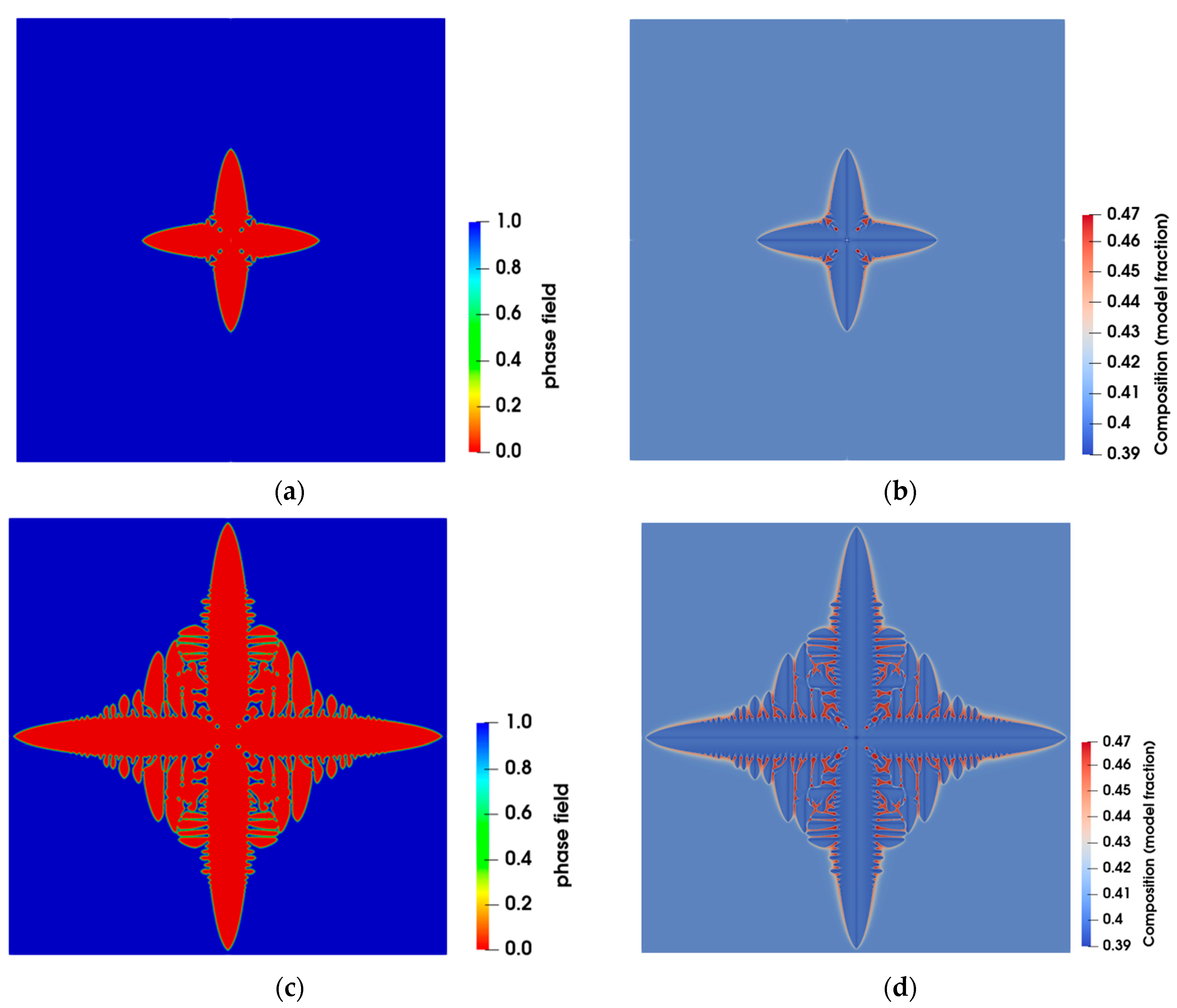
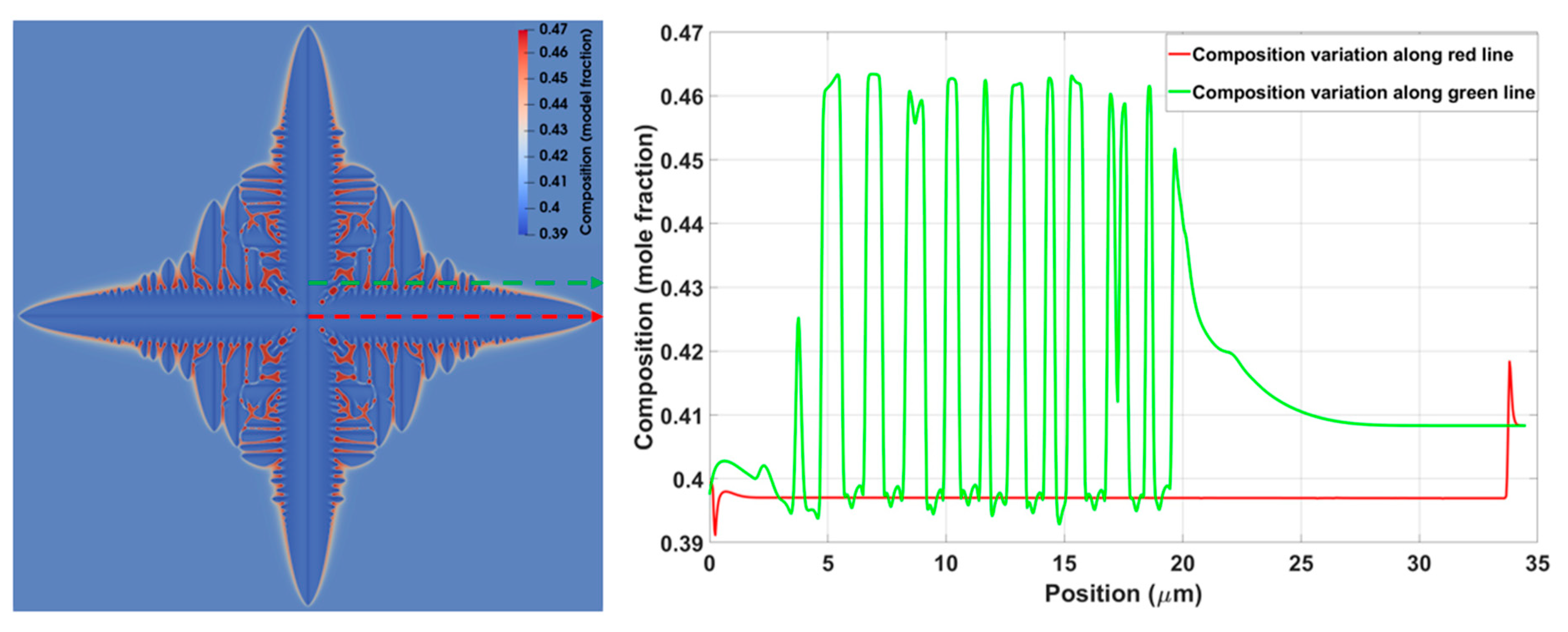




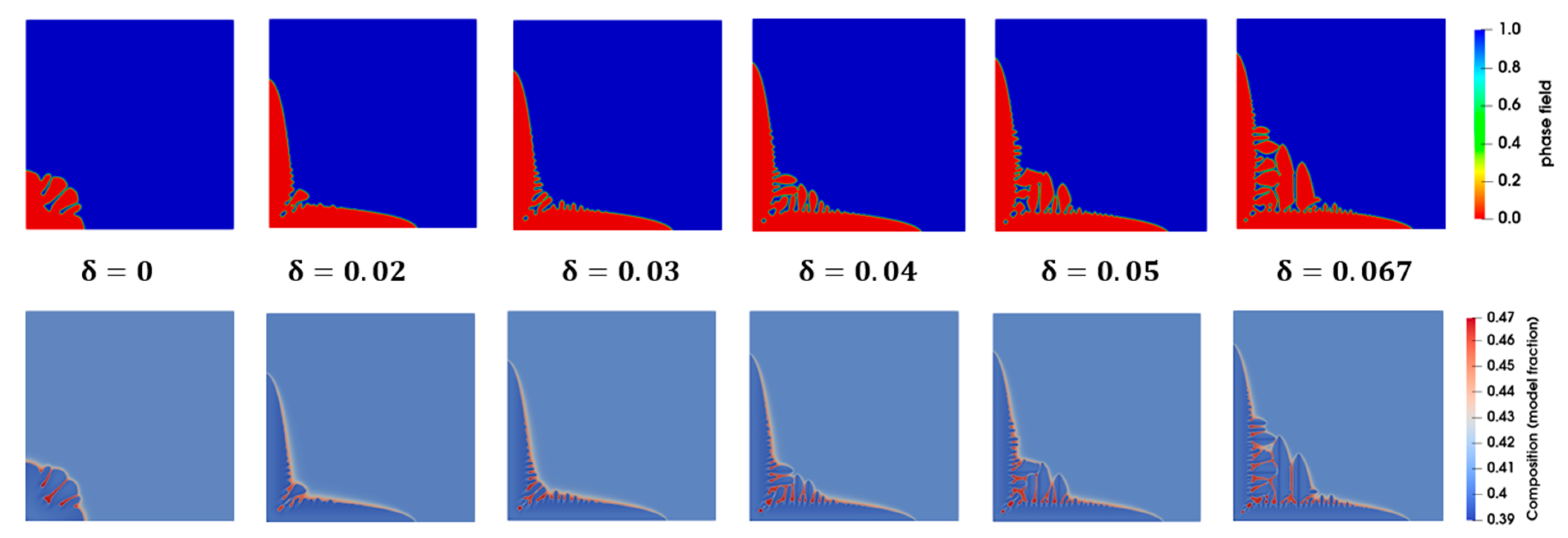
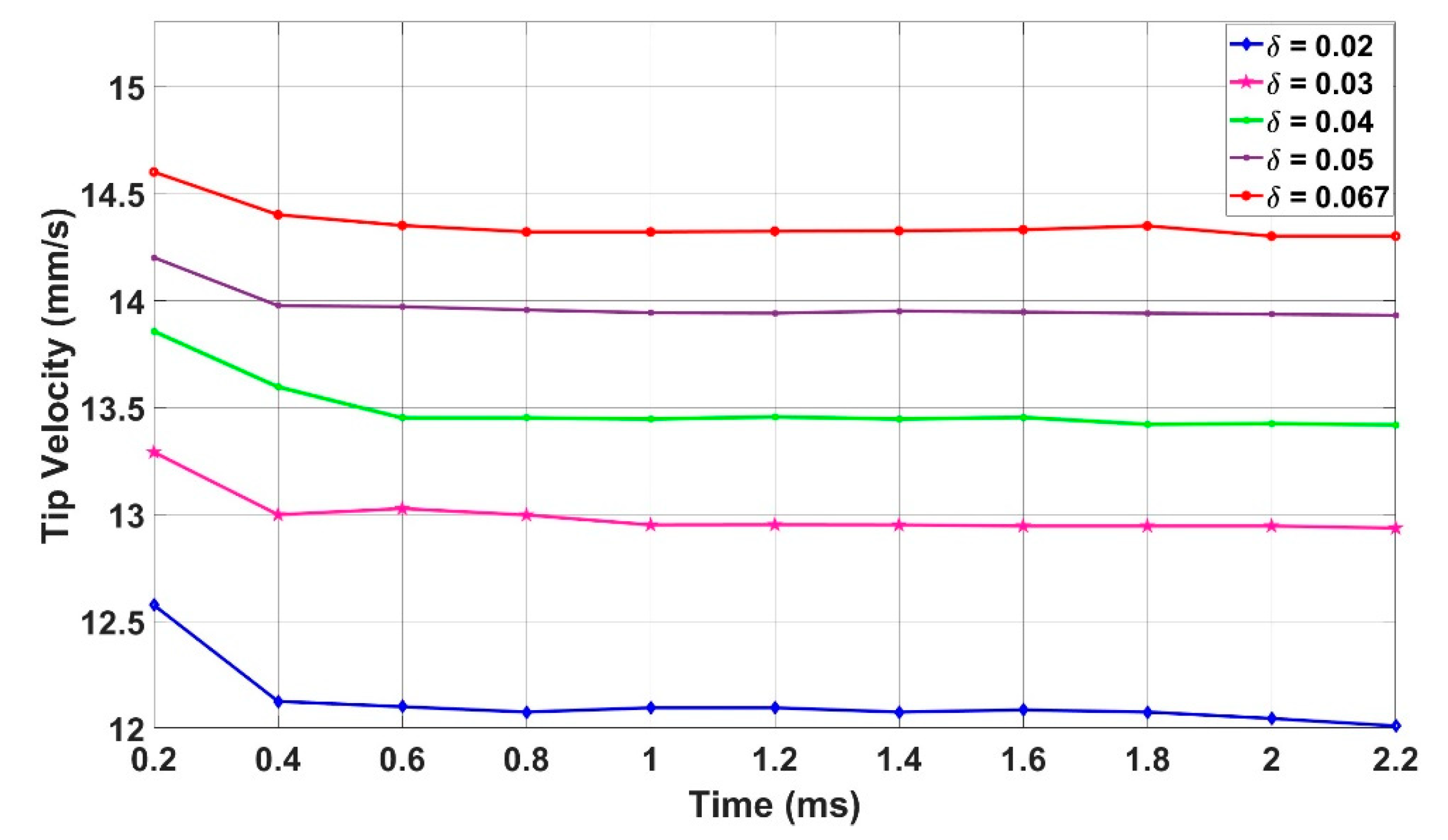

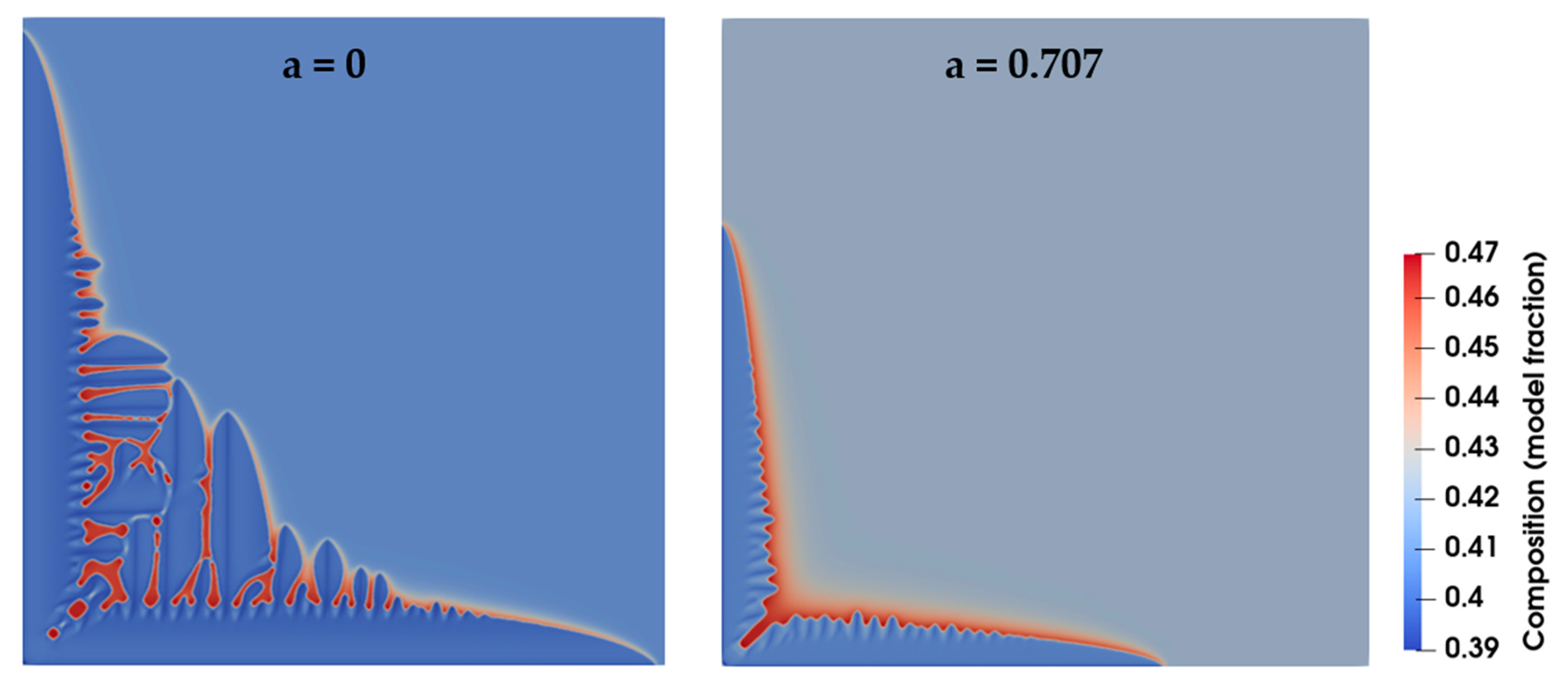
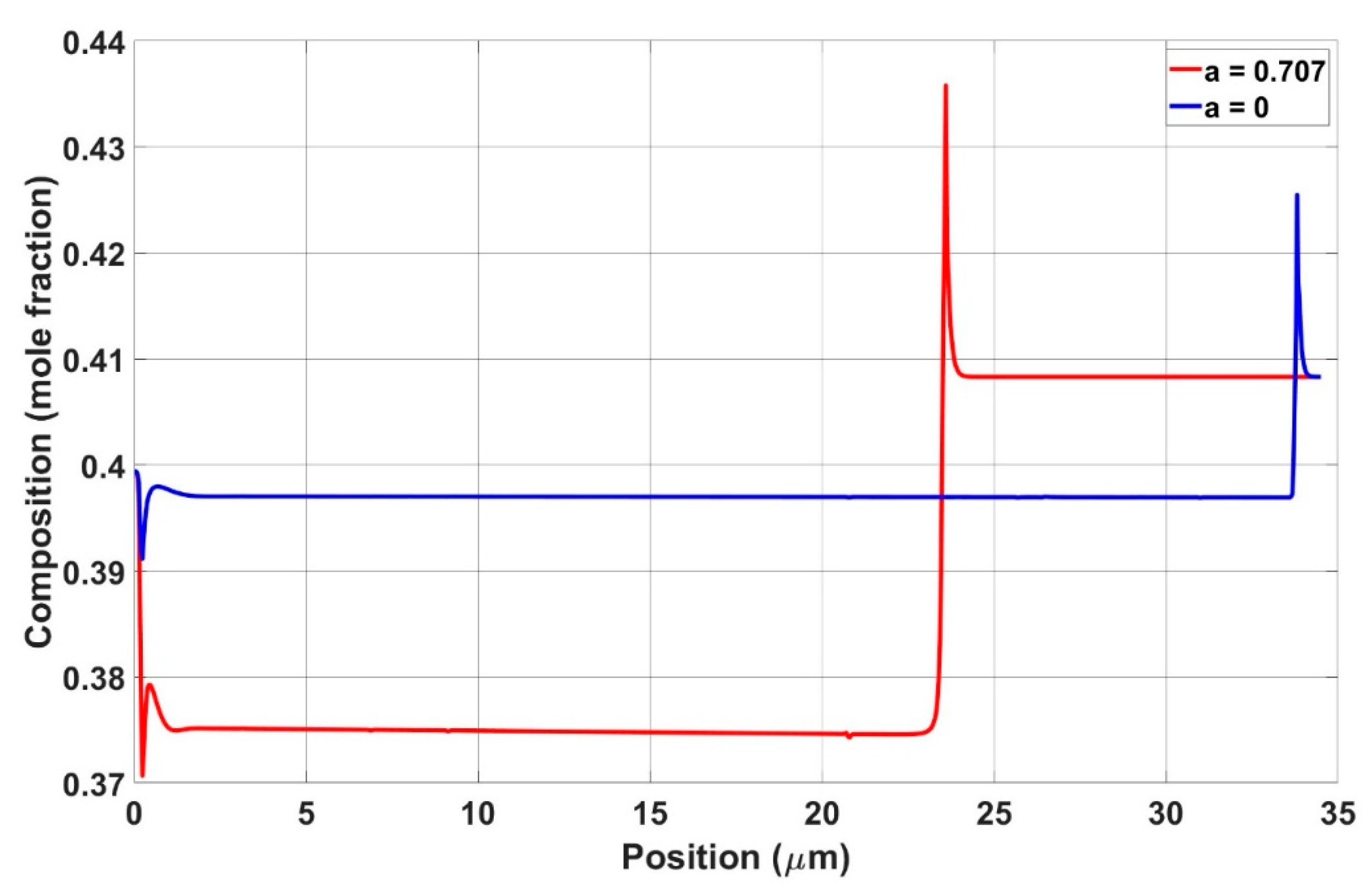
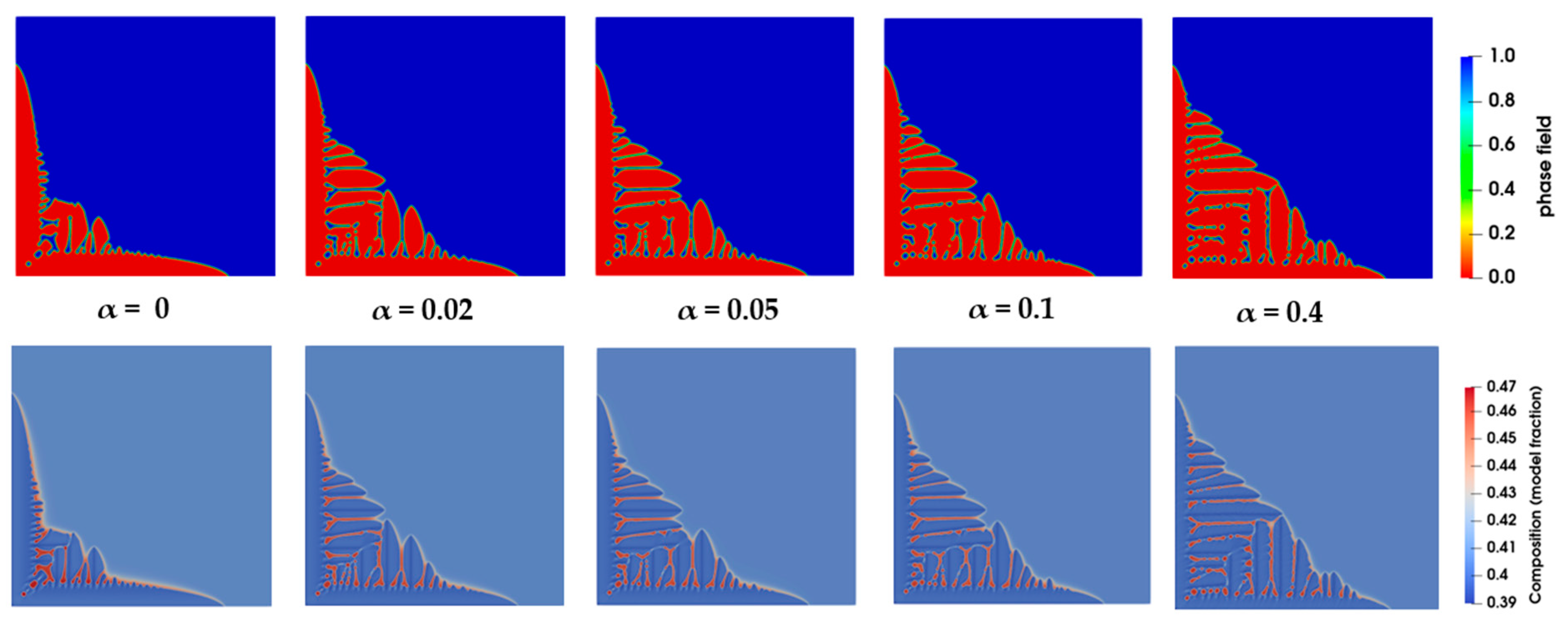


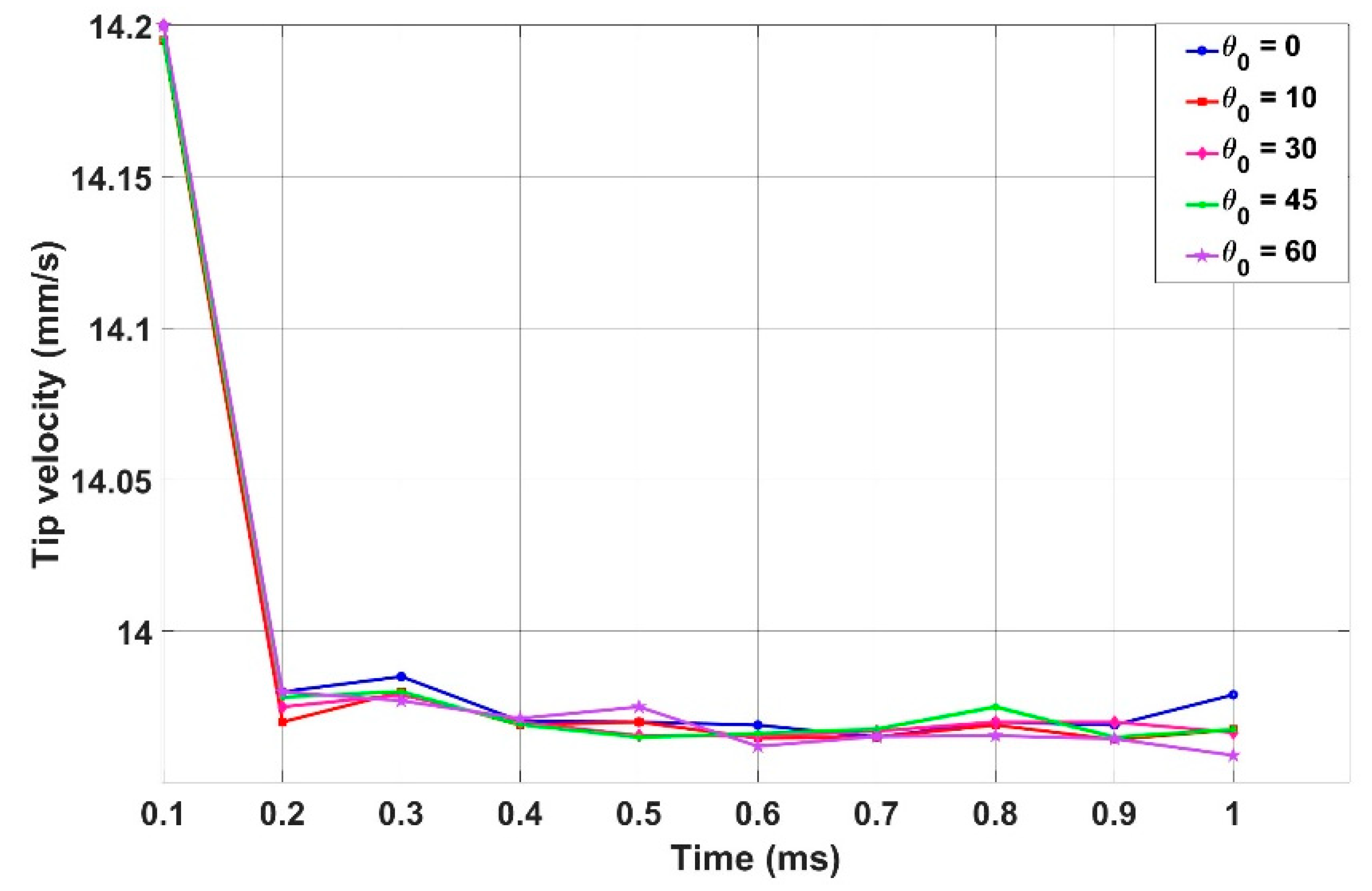


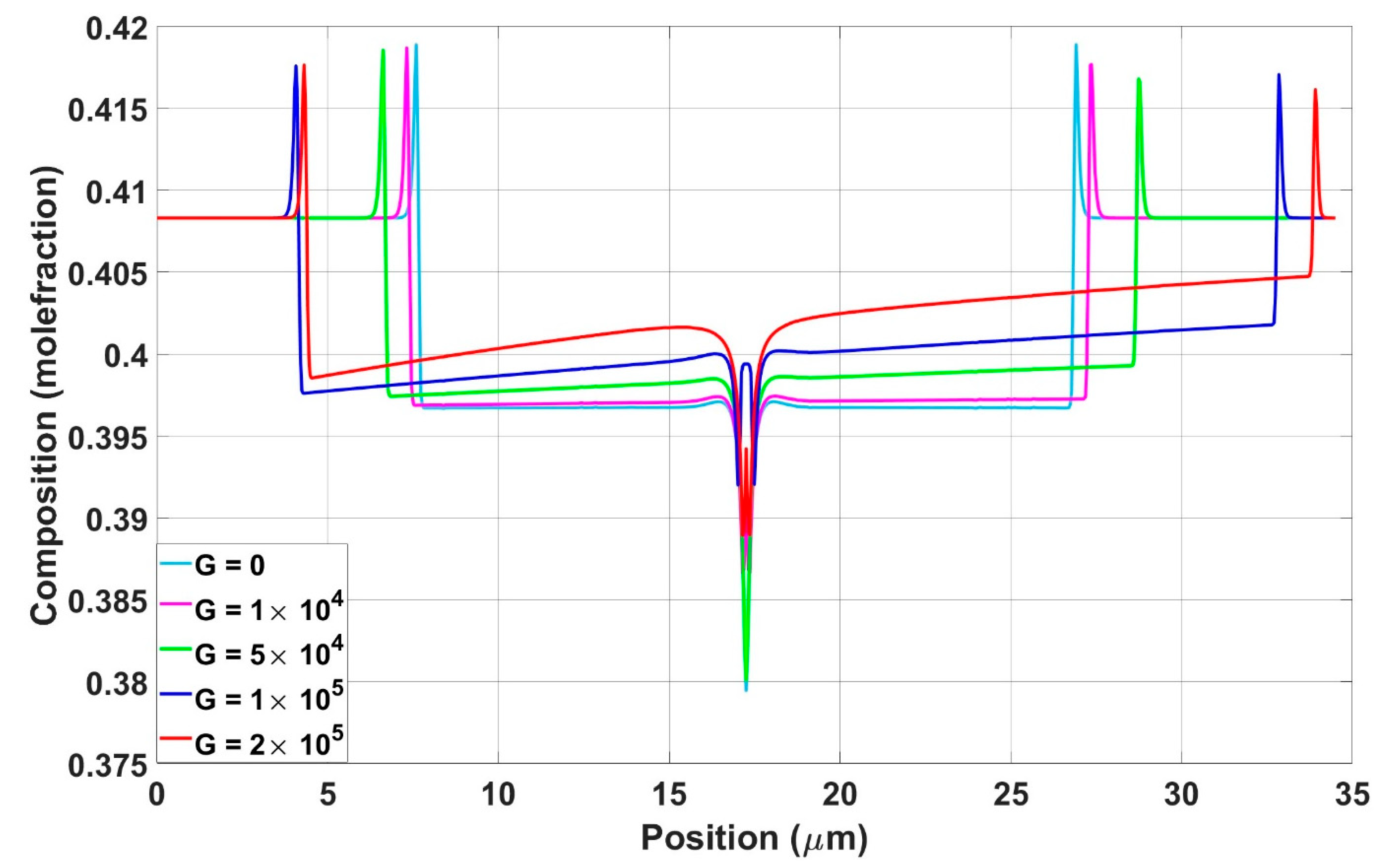
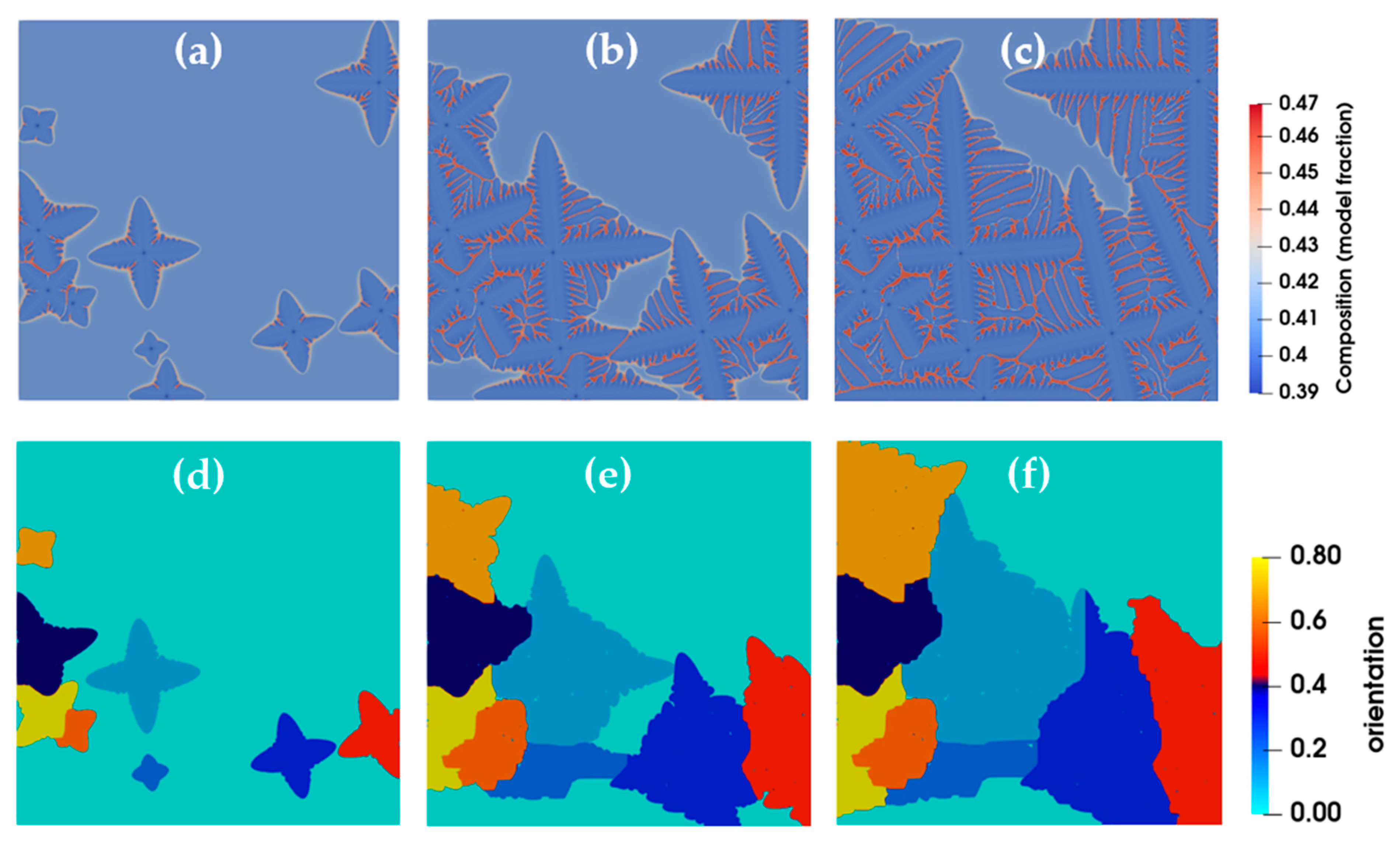

| = | = |
| = | = |
| = = | |
| Interface Thickness (W) (nm) | (Mole Fraction) | (Mole Fraction) | Vtip (mm/s) | Tip Radius () (mm) | |||||
|---|---|---|---|---|---|---|---|---|---|
| 73.4 | 0.39821 | 0.42551 | 0.58419 | 0.942 | 13.98 | 0.194 | 1.246 | 0.794 | 0.8556 |
| 48.9 | 0.396929 | 0.41835 | 0.468699 | 0.948796 | 13.6 | 0.178 | 1.19 | 0.787 | 0.8556 |
| 32.6 | 0.3952 | 0.4216 | 0.503409 | 0.937381 | 14 | 0.114 | 0.73 | 0.73 | 0.8556 |
| 24.5 | 0.39396 | 0.42356 | 0.515203 | 0.930116 | 13.985 | 0.109 | 0.58 | 0.72 | 0.8556 |
| 19.56 | 0.392679 | 0.4251 | 0.517874 | 0.923733 | 13.99 | 0.11 | 0.52 | 0.718 | 0.8556 |
| Antitrapping Constant (a) | (Mole Fraction) | (Mole Fraction) | Vtip (mm/s) | Tip Radius () (μm) | [33] | Vtip [33] (mm/s) | Tip Radius () (μm) [33] | k [33] | ||
|---|---|---|---|---|---|---|---|---|---|---|
| 0 | 0.39821 | 0.42551 | 0.58419 | 14 | 0.178 | 0.593 | 14.2 | 0.942 | 0.178 | 0.943 |
| 0.707 | 0.37921 | 0.43752 | 0.49897 | 10.76 | 0.11 | 0.492 | 10.85 | 0.866 | 0.112 | 0.888 |
Disclaimer/Publisher’s Note: The statements, opinions and data contained in all publications are solely those of the individual author(s) and contributor(s) and not of MDPI and/or the editor(s). MDPI and/or the editor(s) disclaim responsibility for any injury to people or property resulting from any ideas, methods, instructions or products referred to in the content. |
© 2023 by the authors. Licensee MDPI, Basel, Switzerland. This article is an open access article distributed under the terms and conditions of the Creative Commons Attribution (CC BY) license (https://creativecommons.org/licenses/by/4.0/).
Share and Cite
Al Azad, A.R.; Cardiff, P.; Browne, D.J. Development and Numerical Testing of a Model of Equiaxed Alloy Solidification Using a Phase Field Formulation. Metals 2023, 13, 1916. https://doi.org/10.3390/met13121916
Al Azad AR, Cardiff P, Browne DJ. Development and Numerical Testing of a Model of Equiaxed Alloy Solidification Using a Phase Field Formulation. Metals. 2023; 13(12):1916. https://doi.org/10.3390/met13121916
Chicago/Turabian StyleAl Azad, Abdur Rahman, Philip Cardiff, and David J. Browne. 2023. "Development and Numerical Testing of a Model of Equiaxed Alloy Solidification Using a Phase Field Formulation" Metals 13, no. 12: 1916. https://doi.org/10.3390/met13121916






